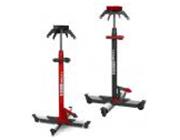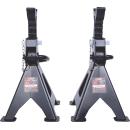Bodywork lifting tools

Lifting stanchions for bodywork
︾
Description of bodywork lifting tools:
Rack and pinion jacks and pit jacks are two pieces of equipment frequently used in the automotive industry, particularly in repair and maintenance workshops. These devices are essential for ensuring the safety of operations under vehicles and facilitate access to the parts located underneath. Here's an overview of the features of each of these items of equipment:
Rack and pinion jacks :
Robust structure:
Rack-mounted stanchions are generally made of steel or sturdy metal, giving them great strength. This ensures stability and safety when used to support a vehicle.
Adjustable rack :
The main feature of rack stands is the presence of a height-adjustable rack. This allows users to adjust the height of the stanchions to suit different types of vehicle and to carry out work at different heights.
Load capacity:
Rack stands are available with different load capacities, allowing users to choose the right model for the weight of the vehicle to be lifted. It is essential to comply with the maximum capacity specified by the manufacturer.
Greater stability :
These stanchions offer excellent stability thanks to their design with four or more legs. This reduces the risk of tipping or instability when working under the vehicle.
Secure locking:
Rack stands feature secure locking mechanisms to hold the rack in position and prevent accidental movement.
Versatility:
They are versatile and can be used for a variety of applications, from simple oil changes to more complex repairs requiring access under the vehicle.
Pit jacks:
Hydraulic design:
Pit jacks use a hydraulic system to lift the vehicle. This provides smooth raising and lowering, allowing precise height control.
High lift:
Pit jacks are designed to provide significant lift, allowing technicians easy access to the lower part of the vehicle, even when positioned in a pit.
Hydraulic controls :
These jacks are often equipped with hydraulic controls allowing users to adjust the height to suit their needs. Some models also offer additional safety features.
High load capacity:
Pit jacks have a high load capacity to support vehicles of different sizes and weights. This makes them a suitable choice for car repair workshops.
Increased stability:
Like rack jacks, pit jacks are designed to provide maximum stability while working under the vehicle.
Pit adaptability:
These jacks are specifically designed for use in a pit, optimising space in the workshop.
In short, rack and pinion jacks and pit jacks are indispensable tools in a car workshop, each with its own characteristics and advantages. The choice between the two depends on the specific needs of the workshop, the type of work to be carried out and the layout of the workspace.
FAQ on the use of lifting tools for bodywork work :
When it comes to using lifting tools in the demanding field of car bodywork, many questions naturally arise from professionals looking to optimise their operations. Here's a look at some of the questions most frequently asked by users about the use of lifting tools in the bodywork industry, with professional answers:
How do you choose the right lifting tool for the type of vehicle and the type of bodywork to be carried out?
The choice of lifting tool depends on a number of factors, such as the weight of the vehicle, the lifting height required and the nature of the work. Lifting platforms, hydraulic jacks, rack and pinion jacks and pit jacks are common options. Consider the load capacity, stability and versatility of the tool to make the best decision for your specific application.
What are the best practices for ensuring safety when using car body lifting tools?
Safety is paramount. Strictly follow the manufacturer's instructions for each lifting tool. Make sure the equipment is properly maintained, check critical components regularly, use lifting points recommended by the vehicle manufacturer, and train staff in the safe use of each tool.
What regular maintenance is required to ensure the longevity of lifting tools?
Regular maintenance is essential. Follow the manufacturer's recommendations for maintenance intervals. Lubricate moving parts, check hydraulic systems, inspect structural components and replace worn parts. Preventive maintenance ensures the reliability and extends the life of your lifting equipment.
Are lifting tools suitable for all types of vehicle, including larger vehicles such as SUVs and trucks?
Lifting tools are available in a variety of capacities to meet the needs of all types of vehicle, including larger ones. Make sure you select a lifting tool with sufficient capacity to support the weight of the vehicle you are planning to lift.
How can lifting tools be used safely on damaged or crashed vehicles?
When lifting damaged vehicles, take extra precautions. Identify the structural lifting points recommended by the vehicle manufacturer, avoid damaged areas, and make sure the vehicle structure is stable before you start lifting.
How do you find the right balance between the cost of lifting tools and their quality in the field of car bodywork?
Think of lifting tools as an investment. Opt for reputable brands that offer the quality and reliability needed to guarantee safety and efficiency. Avoid sacrificing quality for cost, as this can lead to operational problems and long-term safety risks.
In summary, effective use of lifting tools in the bodyshop requires a thorough understanding of the equipment, compliance with safety standards, and a commitment to regular maintenance. By answering these questions, bodyshop professionals can optimise the use of their lifting tools for safe and efficient results.
